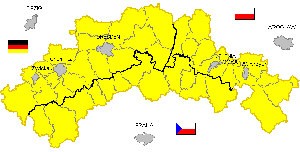|
|
 |
|
|
|
 |
| |
|
|
 |
Climate in cities
Basics |
Areas endangered by air pollution
The air in densely populated and urbanised areas always contains many unwanted substances but sometimes, due to industrial catastrophes, areas with clean air become suddenly very polluted.
|
|
|
|
|
 |
|
As described in the part "What is air pollution?", there are pollutants of global or local influence. The local effects of air pollution include e.g. deterioration of soil, water and vegetation.
|
 |
 |
|
1. Map of Black Triangle area
Please click to see enlarge! (132 K)
Source: Inspectorate of Environmental Protection in Wroclaw. Branch Jelenia Gora
|
|
 |
Air pollution: an international problem
Winds can take the air pollution from a certain place even to another country, and the effects of a pollution emission may be visible far away from the emission source. A good example is the so-called "Black Triangle", an area located at the junction of the Polish, German and Czech borders. There are three big, exploited lignite fields: Turoszow field, Lusatian field and North-Czech field, together with seven power plants of total power 16,000 MW. In 1989, this region covering as little as 32,400 km2 (i.e. smaller than Switzerland) delivered 30% of European SO2 emission, contributing significantly to the acid rains occurrence (see also the section "Areas endangered by acid rains"). It caused the largest in Europe event of mountain forest decay, which occurred in the Sudety Mts. In the period 1981-1987, 11,000 ha of spruce tree forest was damaged, of which 10,000 in the Western Sudety Mts. At the same time, in north-west Czech lands and in Saxony, totally 15,000 ha of forest decayed. Thanks to the co-operation of the three countries, at the beginning of 1990s actions aiming at improvement of the natural environment were undertaken. In 1992, an integrated network of 43 automatic monitoring stations was established in Poland, Czech Republic and Germany. The sources of SO2 emission were limited by modernisation of power plants and heating systems. Another factor that contributed to the improvement of air quality was the economic crisis and decrease in industrial production in the Central European countries. Due to all those circumstances, the emissions of harmful substances diminish every year. |
2. Dust, SO2 and NOx emission on the area of Balck Triangle
Please click icon to see enlarged chart! (69-76 K)
Source: Inspectorate of Environmental Protection in Wroclaw. Branch Jelenia Gora |
Industrial catastrophes
Technological risk is an element that has accompanied the industry development from its beginning. Every installation may begin to malfunction at a certain moment of its operation, and people working with the machines and systems may always make a mistake. When an industrial catastrophe takes place, the atmosphere usually gets polluted with very toxic chemicals or radioactive substances, like in the case of nuclear power plant injury.
|
 |
 |
 |
|
3. Chemical complex
Source: www.freefoto.com
|
|
|
Here are a few examples of such events and their effects:
- 1930 - smog in the Mosa valley (Belgium), air pollution with sulphur oxides caused the death of a few hundred persons,
- 1948 - Donora (USA), smog killed 20 persons,
- 1950 - Pozza Rica (Mexico), uncontrolled emission of hydrogen sulfide (H2S) during a plant malfunction caused intoxication of over 300 persons, from which 22 died,
- 1952 - smog in London, 4 thousand persons died,
- 1984 - chemical catastrophe in Bhopal (India), 3.4 thousand persons died, 600 thousand were intoxicated,
- 1986 - injury of the nuclear power plant in Chernobyl (former USSR, present Ukraine), 31 persons died in the first week after the explosion, but until today the exact number of victims is not known; it is estimated that a few million people suffer from diseases caused by the radiation: cancer (an increase of thyroid cancer is observed in the surrounding area), immunology dysfunction etc.; large areas were polluted for many years,
- 1991-92 - fires of oil pits during the war in Kuwait and Iraq.
|
|
About this page:
Authors: Pawel Jezioro, Anita Bokwa - Jagiellonian University - Cracow / Poland
Supporter: Grzegorz Wawrejko
1. Scientific reviewer: Prof. Barbara Obrebska-Starkel - Jagiellonian University - Cracow / Poland - 2003-06-20
2. Scientific reviewer: Dr. Marek Nowosad - Maria Curie-Sklodowska University - Lublin / Poland - 2003-06-16
educational reviewing:
last update: 2004-12-17
|
|
 |
|









